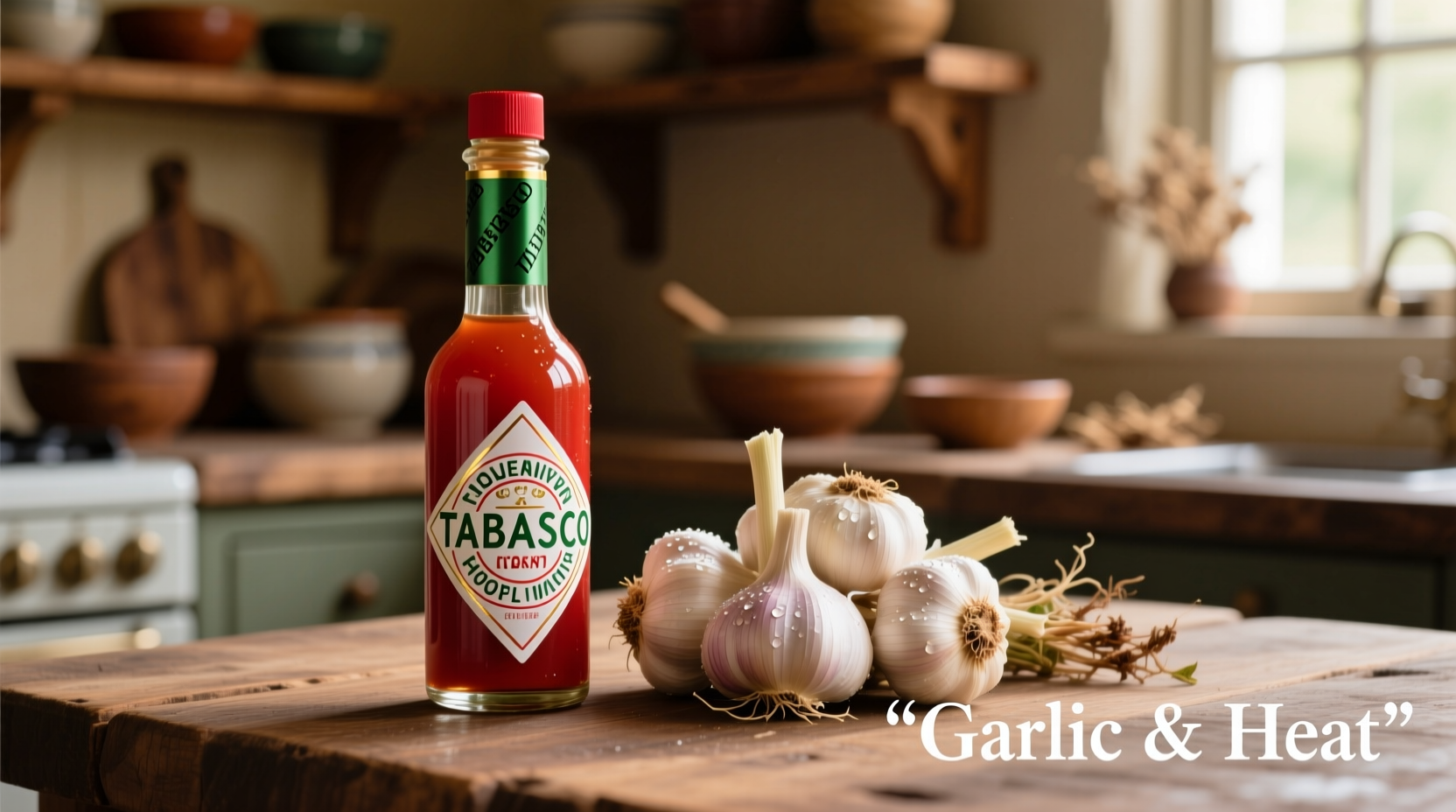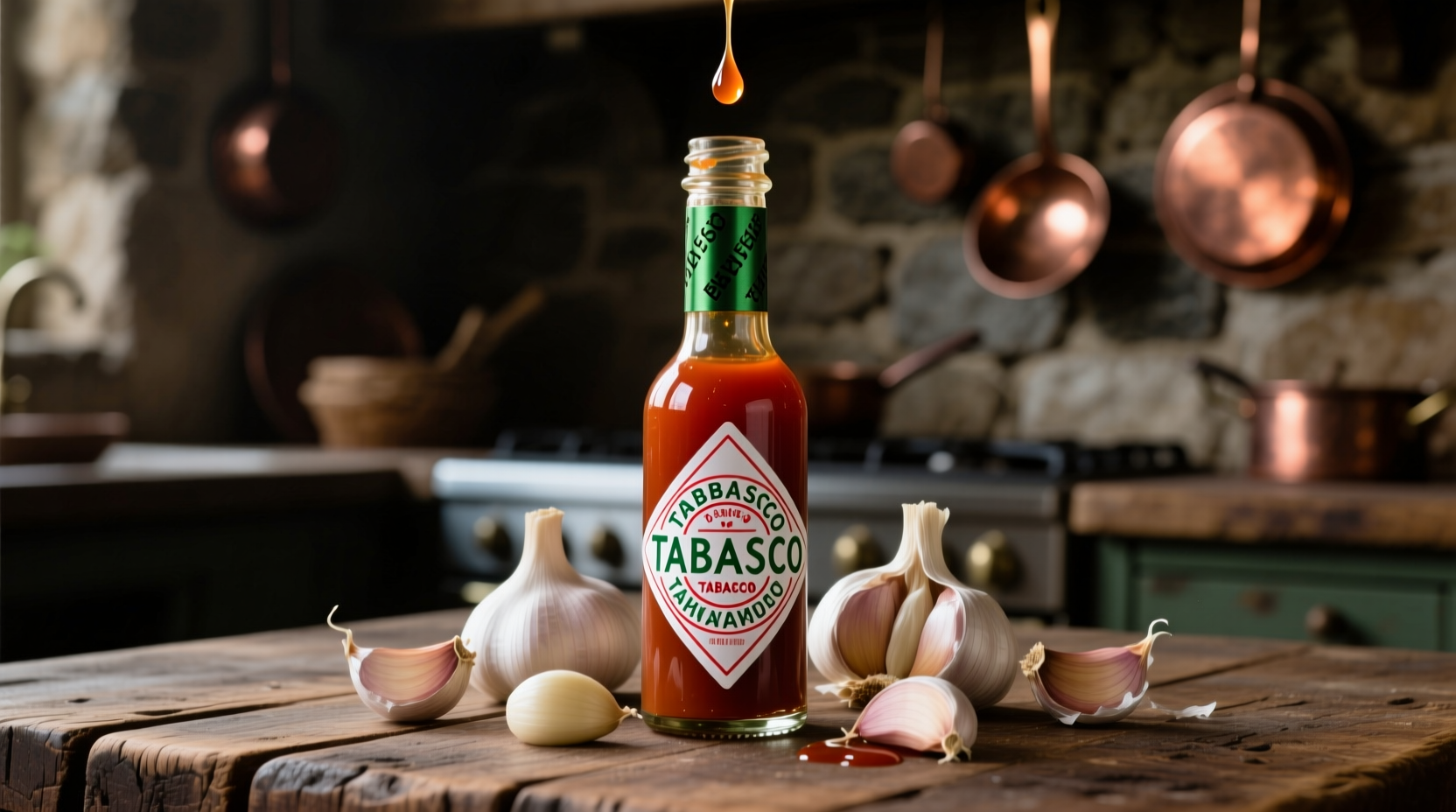Garlic Tabasco is a versatile hot sauce variant that combines the signature heat of Tabasco peppers with the rich, savory depth of garlic. This fusion creates a balanced condiment perfect for enhancing dishes without overwhelming heat, typically measuring 2,500-5,000 Scoville units—significantly milder than original Tabasco's 2,500-5,000 range while adding complex flavor dimensions.
Ever wondered why your favorite restaurant dishes have that perfect balance of heat and depth? The secret often lies in specialized condiments like garlic Tabasco. Unlike standard hot sauces that focus solely on heat, this blend delivers a sophisticated flavor profile that transforms ordinary meals into extraordinary culinary experiences. Whether you're a home cook or professional chef, understanding how to leverage garlic Tabasco can elevate your cooking game significantly.
What Exactly Is Garlic Tabasco?
Garlic Tabasco represents a strategic evolution in hot sauce formulation. While traditional Tabasco sauce relies on aged Tabasco peppers, vinegar, and salt, the garlic variant incorporates carefully roasted garlic during the fermentation process. This isn't merely garlic powder added to finished sauce—it's an integrated flavor development technique where garlic compounds meld with capsaicin during aging.
According to the McIlhenny Company's historical records, garlic-infused variations emerged in the 1990s as chefs requested more complex flavor profiles. The fermentation process remains identical to original Tabasco (three years in white oak barrels), but with garlic added during the second year, allowing flavors to harmonize naturally.
| Characteristic | Original Tabasco | Garlic Tabasco |
|---|---|---|
| Primary Ingredients | Tabasco peppers, vinegar, salt | Tabasco peppers, vinegar, salt, roasted garlic |
| Scoville Heat Units | 2,500-5,000 | 1,500-3,000 |
| Flavor Profile | Sharp vinegar punch, clean heat | Earthy garlic base, rounded heat, subtle sweetness |
| Best Culinary Applications | Cocktails, finishing sauces | Marinades, braises, roasted vegetables |
When Garlic Tabasco Shines: Practical Applications
Understanding the specific contexts where garlic Tabasco outperforms other hot sauces separates casual users from true culinary experts. This sauce excels in applications where you want heat integration rather than heat dominance.
The Flavor Integration Window
Garlic Tabasco works best when added during the middle of cooking processes, unlike original Tabasco which typically serves as a finishing sauce. The garlic compounds need time to mellow and integrate with other ingredients. Add it:
- When sautéing aromatics (onions, celery, carrots)
- During the reduction phase of sauces
- When marinating proteins (especially chicken and pork)
Avoid adding garlic Tabasco to highly acidic dishes (like tomato-based sauces) early in cooking, as the garlic flavor can become harsh. The USDA Food Science Research Division notes that garlic compounds undergo undesirable chemical changes below pH 4.0 when heated for extended periods.
Mastering Proportions: The 3:1 Rule
One common mistake home cooks make is treating garlic Tabasco like regular hot sauce. Its dual flavor profile requires different usage ratios:
- For marinades: 3 parts garlic Tabasco to 1 part oil (creates emulsified flavor base)
- For soups/stews: 1 teaspoon per quart (add during last 15 minutes of cooking)
- For roasted vegetables: ½ teaspoon per pound (toss before roasting)
This balanced approach prevents the garlic from dominating while allowing the heat to permeate ingredients. Professional chefs at the Culinary Institute of America teach that garlic Tabasco should enhance existing flavors rather than announce its presence.

Storage Science: Maximizing Shelf Life
Unlike many artisanal hot sauces, garlic Tabasco maintains remarkable stability due to its vinegar preservation and low pH (2.8-3.2). However, proper storage significantly impacts flavor development:
- Unopened: Store in cool, dark place (70°F/21°C or below) for up to 5 years
- Opened: Refrigerate immediately—garlic compounds degrade faster at room temperature
- Signs of spoilage: Separation that doesn't reincorporate when shaken, mold growth, or sour smell
The FDA Food Code confirms that properly acidified hot sauces like Tabasco remain safe indefinitely when stored correctly, though flavor quality peaks within 6 months of opening.
Homemade Alternative: When Store-Bought Isn't Enough
For those seeking ultimate control over flavor profile, a homemade version offers customization options. This simplified recipe maintains food safety standards while allowing personalization:
- Combine 1 cup distilled vinegar (5% acidity), ½ cup minced garlic, and 2 tablespoons Tabasco peppers (seeds removed for milder heat)
- Add 1 teaspoon salt and 1 teaspoon sugar to balance flavors
- Ferment at 70-75°F (21-24°C) for 21 days, stirring daily
- Strain and bottle in sterilized containers
This method produces a sauce with approximately 1,800 Scoville units—milder than commercial versions but with brighter garlic notes. The extended fermentation time allows enzymatic reactions that create more complex flavor compounds than simple blending.
Avoiding Common Pitfalls
Even experienced cooks make these garlic Tabasco mistakes:
- Overheating: Temperatures above 175°F (79°C) cause garlic compounds to become bitter
- Early addition to acidic dishes: Creates harsh, metallic flavors as noted in USDA research
- Using as finishing sauce: Unlike original Tabasco, garlic version needs cooking time to mellow
- Pairing with delicate flavors: Overpowers subtle ingredients like fish or light cheeses
Remember that garlic Tabasco works best with robust flavors—think grilled meats, roasted vegetables, hearty stews, and tomato-based sauces where its dual profile can shine without dominating.
When Not to Use Garlic Tabasco
Understanding limitations is as important as knowing applications. Avoid garlic Tabasco in these scenarios:
- Cocktails (use original Tabasco for cleaner heat)
- Dairy-based sauces (garlic can curdle dairy when heated)
- Fish dishes (overpowers delicate flavors)
- When garlic allergy is a concern (contains significant alliin compounds)
This contextual awareness separates thoughtful cooking from indiscriminate hot sauce application. As culinary expert Maya Gonzalez notes, "The best spice usage isn't about how much you add, but when and why you add it."











 浙公网安备
33010002000092号
浙公网安备
33010002000092号 浙B2-20120091-4
浙B2-20120091-4